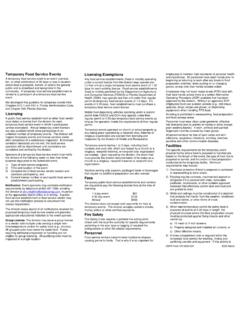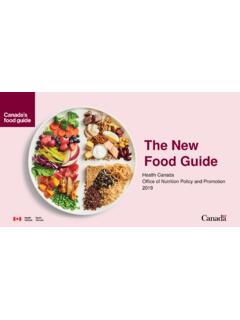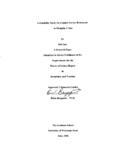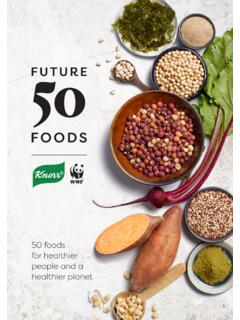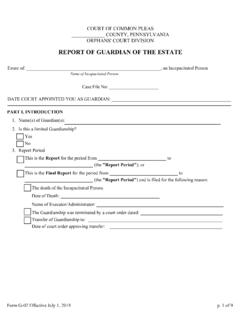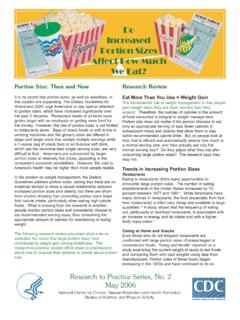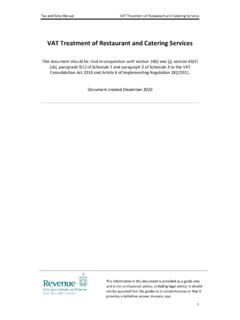Transcription of Food Service Guidelines for Federal Facilities
1 food Service Guidelinesfor Federal Facilities ContributorsContributors to the authorship of the food Service Guidelines for Federal Facilities were from the food Service Guidelines Federal Workgroup. This workgroup consisted of more than 60 representatives from the following nine Federal departments and agencies: Department of Health and Human services General services Administration Department of Agriculture Department of Commerce Department of Defense Department of Education Environmental Protection Agency Department of Interior Department of Veterans Affairs Suggested Citation: food Service Guidelines Federal Workgroup. food Service Guidelines for Federal Facilities . Washington, DC: Department of Health and Human services ; ..5 Purpose, Goals, and Audience for the food Service Guidelines for Federal Facilities ..6 Standards for the food Service Guidelines for Federal Facilities .
2 9 food and Nutrition Standards ..10 Facility Efficiency, Environmental Support, and Community Development Standards ..14 food Safety Standards ..18 Behavioral Design ..20 Glossary ..23 References ..27 PAGE INTENTIONALLY LEFT BLANK 5 Introduction 6 The Department of Health and Human services (HHS) and the General services Administration (GSA) collaboratively released the first food Service Guidelines for Federal Facilities in March 2011 in an effort to assist employees in making healthier food and beverage choices and to create an efficient and environmentally beneficial food Service Those Guidelines , Health and Sustainability Guidelines for Federal Concessions and Vending Operations,1 (referred to here as the 2011 HHS / GSA Guidelines ) have been updated and renamed, food Service Guidelines for Federal Facilities . Updates to the food Service Guidelines for Federal Facilities primarily include the following: 1) alignment of food and nutrition standards with the 2015 2020 Dietary Guidelines for Americans, 8th Edition2 (referred to here as the 2015 2020 Dietary Guidelines ); 2) alignment with Executive Order 13693 (Planning for Federal Sustainability in the Next Decade)3 on energy efficiency and environmental performance; 3) additions of food safety standards aligned with the food Code4 to ensure protection against foodborne illnesses; and 4) behavioral design strategies for encouraging selection of healthier foods and of the food Service Guidelines for Federal FacilitiesThe standards in the food Service Guidelines for Federal Facilities are designed to achieve three primary goals.
3 These goals are to ensure that:zzHealthier foods and beverages are available and encouraged at Federal Facilities . zzEnvironmentally responsible practices are conducted in Federal food Service venues, and communities are economically supported through local food safety practices are followed to minimize the risk of foodborne illnesses. Purpose, Goals, and Audience for the food Service Guidelines for Federal FacilitiesThe purpose of the food Service Guidelines for Federal Facilities is to provide specific standards for food , nutrition, facility efficiency, environmental support, community development, food safety, and behavioral design for use in food Service concession and vending operations at Federal Facilities ; examples include cafeterias, caf s, snack bars, grills, concession stands, sundry shops, micro markets,*1 and vending machines. The food Service Guidelines for Federal Facilities is to be used primarily for developing contracts and permits for the delivery of food Service in these settings.
4 The intended audiences for this document are Federal acquisition officials and staff who develop requests for food Service proposals and negotiate contracts; food Service vendors competing for Federal food Service contracts; participants in the Randolph-Sheppard Vending * See glossary for Program; 2 and persons who monitor or advise food Service operations, such as worksite wellness stakeholders or contracting officers. The Guidelines in this document may also serve as a model for concession and vending operations at state, local, and tribal government and private worksite Facilities . Two types of food Service are provided in Federal Facilities . One type includes food Service venues in which food is sold (such as cafeterias, caf s, and vending machines) and customers purchase their food and beverages from a variety of choices. The other type includes venues in which food is served (such as Federal hospitals, correction Facilities , or military dining Facilities ), and the government is responsible for providing individuals with meals that meet all or part of their daily or weekly nutrition needs and individual choice may be limited.
5 3 With the exception of the food safety standards, which apply in both types of venues, the standards in the food Service Guidelines for Federal Facilities are written specifically for Federal food Service venues where food is sold (although they can be adapted to venues where food is served ).Process for Updating the food Service Guidelines for Federal Facilities The standards included in this update were determined by the food Service Guidelines Federal Workgroup, which consisted of more than 60 representatives from nine Federal departments and agencies. The workgroup formed three subcommittees ( food and Nutrition, Facility Efficiency and Procurement, and food Safety) and a subgroup (Behavioral Design Working Group) to determine the standards for inclusion in the food Service Guidelines for Federal Facilities . Details of the complete process for updating the food Service Guidelines for Federal Facilities and the rationales for decisions regarding the standards are found in An Ancillary Report of the food Service Guidelines for Federal The Randolph-Sheppard Vending Facility Program provides persons who are blind with remunerative employment and self-support through the operation of vending Facilities on Federal and other property.
6 See for more information. The food Service Guidelines for Federal Facilities does not apply to food served to children in child care or school settings that are governed by Federal laws and regulations, including the National School Lunch Program, the School Breakfast Program, the Child and Adult Care food Pro-gram, and the Summer food Service Program. 8 PAGE INTENTIONALLY LEFT BLANK Standards for the food Service Guidelines for Federal Facilities 10 Best Business Practices The food Service Guidelines for Federal Facilities represents a set of voluntary best business practices that can be implemented at Federal departments and agencies to increase healthy and safe food options for employees, while also improving facility efficiency and supporting the community through sourcing and procurement of local and regional standards in the food Service Guidelines for Federal Facilities are categorized into four sections.
7 These are food and Nutrition; Facility Efficiency, Environmental Support, and Community Development; food Safety; and Behavioral Design. The food Service Guidelines for Federal Facilities identifies two levels of implementation: Standard and Innovative. The criteria for both implementation levels are supported by the scientific literature to be beneficial to health and / or the environment, or align with existing national policy or guidance. These terms are defined as follows: zzStandard criteria are considered to be widely achievable within food Service . Implementation at the standard level is expected. zzInnovative criteria promote exceptional performance in various areas of food Service . Implementation at the innovative level is and Nutrition StandardsThe United States government encourages the availability, promotion, and consumption of healthier foods and beverages as a way to support optimal health and prevent nutrition-related chronic diseases,2 several of which are among the leading causes of The 2015 2020 Dietary Guidelines , published by HHS and the Department of Agriculture (USDA), outlines healthy diets for people aged 2 years and older and states that all segments of society individuals, families, communities, businesses and industries, organizations, government, and others can and should align with the Dietary Guidelines .
8 2 The 2015 2020 Dietary Guidelines serves as the basis for the food and Nutrition standards included in the food Service Guidelines for Federal the 2011 HHS / GSA Guidelines , the food and nutrition standards were categorized as Concessions and Vending. In the updated food Service Guidelines for Federal Facilities , the standards are classified as Prepared Foods, Packaged Snacks, and Beverages (Tables 1, 2 and 3) to simplify guidance for the vendor, and to ensure that standards for similar products applyacross all types of food Service venues. Using this categorization of standards, the criteria canapply across all concession and vending operations, except as noted. The categories are definedas follows:11zzPrepared Foods. This category includes foods that are fresh, cleaned, cooked, assembled ( , salad or sandwich), or otherwise processed and served ready-to-eat. Prepared foods include those that are made and served on site, or those prepared at a central kitchen and then packaged and distributed to other locations.
9 These foods have a relatively limited shelf-life (compared to packaged snacks), and can be sold in any food Service venue. Examples of prepared foods include hot entr es, side dishes, soups, salads, deli sandwiches, and fresh whole fruits and vegetables. zzPackaged Snacks. This category includes processed foods that are packaged in small portions or individual servings, are widely distributed, and have a relatively long shelf-life (compared to prepared foods). Packaged snacks include food items such as granola bars, chips, crackers, raisins, and nuts and seeds. These foods can be sold in any venue, such as vending machines or grab-n-go areas of cafeterias. zzBeverages. This category includes drinks such as water, milk, 100% juice, soft drinks, energy drinks, teas, and coffees. Table 1. food AND NUTRITION Standards for Prepared Foods, food Service Guidelines for Federal FacilitiesCategoryStandardsImplementatio n LevelaFruits and VegetablesOffer a varietyb of at least 3 fruitc options daily, with no added sugars.
10 Fruit ecan be fresh, canned,d frozen, or a varietyb of at least 3 non-fried vegetable options daily. Vegetables can be fresh, frozen, or canned, and served cooked or raw. StandardStandard Offer seasonal fruit and GrainsOffer half of total grains as whole grain-rich products,b a whole grain-rich productb as the first ( , defaultb) choice. Standard Innovative DairyOffer a variety of low-fat dairy productsb (or dairy alternatives) daily, such as milk, yogurt, cheese, and fortified soy yogurt is available, offer at least one low-fat plain yogurt. Standard Innovative Offer a varietyb of non-fried protein foods, such as seafood,b lean meats and poultry,b eggs, legumes (beans and peas), nuts, seeds, and soy products, Protein FoodsOffer protein foods from plants, such as legumes (beans and peas), nuts, seeds, and soy products, at least three times per protein foods from plants such as legumes (beans and peas), nuts, seeds, and soy products, Innovative Offer seafoodb at least two times a week.










